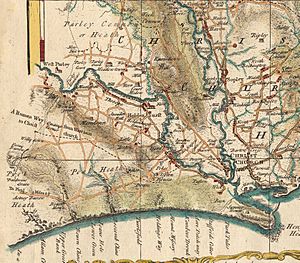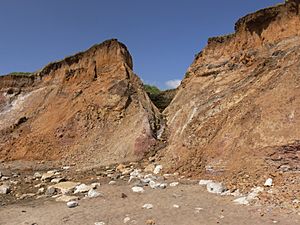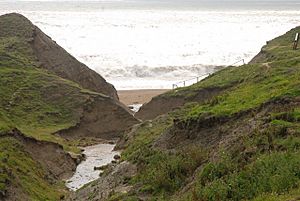Chine facts for kids
A chine is a special type of steep, narrow valley or gorge found along coastlines. It forms where a small river or stream flows into the sea, usually cutting through soft cliffs made of sandstone or clay.
You'll find the word "chine" used mainly in parts of Southern England, like East Devon, Dorset, Hampshire, and the Isle of Wight. Sometimes, in Hampshire, these features are called "bunnies." Interestingly, some areas in Vancouver, Canada, also use the term "chine" for similar coastal valleys.
How Chines Form and Change
Chines begin to form when a stream reaches the edge of a cliff and creates a waterfall. Over time, the water erodes the soft rock, carving a deep gully or valley down to the sea. This process needs the right mix of rock types, enough water in the stream, and the coastline slowly wearing away.
Chines are always changing because of erosion. For example, Blackgang Chine on the Isle of Wight has been greatly changed by landslides and coastal erosion over the last century. Because the cliffs and chine walls are unstable and constantly eroding, you can often see the different layers of rock very clearly. This makes chines important places for finding fossils and learning about archaeology. They also provide a unique home for special plants and animals, like rare insects.
Chines in the UK

Many chines are found along the coast of the United Kingdom. In Devon, you can find Sherbrooke Chine and Seaton Chine. Dorset has several well-known chines near Bournemouth, such as Flaghead Chine, Branksome Chine, Alum Chine, Middle Chine, and Durley Chine. East of Bournemouth, there are Boscombe Chine and Honeycombe Chine. The town center of Bournemouth itself was built in what used to be the Bourne Chine.
Other examples include Becton Bunny and Chewton Bunny near Barton on Sea, Hampshire. Here, "Bunny" is the local name for a chine, especially in the New Forest area.
There's even a rare example of "Chine" being used away from the coast, in a place called Chineham near Basingstoke.
Chines on the Isle of Wight
The Isle of Wight is home to twenty chines. These natural features have a rich history, often linked to local smuggling, fishing, and shipwrecks, which has led to many interesting local stories. Shanklin Chine is a popular tourist spot and played a role in the Second World War. It was used to carry one of the Operation Pluto pipelines, which supplied fuel across the English Channel. It was also a training area for the 40 Royal Marine Commando battalion before the 1942 Dieppe Raid.
The chines on the Isle of Wight are made of different types of rock. Those in Alum Bay, Totland (like Widdick Chine), and the three in Colwell Bay (Colwell Chine, Brambles Chine, and Linstone Chine) are found in younger, Tertiary rocks. The rest of the chines on the island's south coast are in older, Cretaceous rocks.
Here is a list of chines on the Isle of Wight, starting from Cowes and moving clockwise around the island:
- Shanklin Chine
- Luccombe Chine
- Blackgang Chine
- New Chine
- Walpen Chine
- Ladder Chine
- Whale Chine
- Shepherd's Chine
- Cowleaze Chine
- Barnes Chine
- Grange/Marsh Chine
- Chilton Chine
- Brook Chine
- Churchill Chine
- Shippards Chine
- Compton Chine
- Alum Bay Chine
- Widdick Chine
- Colwell Chine
- Brambles Chine
- Linstone Chine
Chines in Canada
In Canada, the Vancouver suburb of Coquitlam has neighborhoods named Harbour Chines and Chineside. These areas are built on top of cliffs that overlook many streams. These streams flow down to Chines Park in the nearby suburb of Port Moody, and from there, they flow into Burrard Inlet, then out to the Strait of Georgia in the Salish Sea, and finally into the Pacific Ocean.




